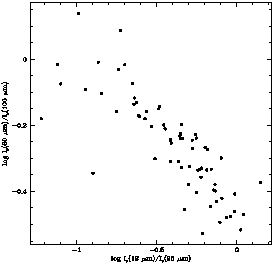


3.1.3. IRAS Colors
Mid- and far-infrared color ratios describe the shape of the dust emission at
those wavelengths. To first order, the spectra of normal galaxies are
organized
into a single family of curves, manifested as a linear locus that galaxies
occupy in the IRAS color-color diagram
(Helou 1986).
This diagram was quite
surprising at first look, since it implies that the spectrum becomes cooler
when judged by the mid-infrared R(12, 25) =
f (12 µm) /
f
(12 µm) /
f (25 µm)
color as it gets warmer in the far-infrared
color ratio R(60, 100) =
f
(25 µm)
color as it gets warmer in the far-infrared
color ratio R(60, 100) =
f (60 µm) /
f
(60 µm) /
f (100 µm)
(Figure 2).
It turns out that this behavior results from the interplay
of two spectral components: blackbody-like emission from classical grains in
temperature equilibrium mostly at the longer wavelengths, and relatively
fixed-shape mid-infrared emission from tiny grains with a few hundred
atoms or less,
intermittently heated by single photon events (more in
Section 4.2).
(100 µm)
(Figure 2).
It turns out that this behavior results from the interplay
of two spectral components: blackbody-like emission from classical grains in
temperature equilibrium mostly at the longer wavelengths, and relatively
fixed-shape mid-infrared emission from tiny grains with a few hundred
atoms or less,
intermittently heated by single photon events (more in
Section 4.2).

|
Figure 2. The IRAS color-color diagram describes the variation in the shape of the infrared emission from interstellar dust as the star formation activity and dust heating vary in the galaxy. This plot shows the data for the sample used in the ISO Key Project on Normal Galaxies (cf. Section 4.1). |
The seqence of infrared colors in Figure 2 was clearly associated with a progression towards greater dust-heating intensity, as illustrated by the progression of colors in the California Nebula as one approaches the heating star (Boulanger et al. 1988). The cool end of the color sequence corresponds to cool diffuse HI medium and to quiescent molecular clouds, whereas the warm end corresponds to the colors of HII regions, star-bursts and galaxies with high IR/B ratios and higher infrared luminosity. It is thus natural to associate the color progression with a sequence of star formation activity in galaxies, signalling in simplest terms an increase of the fraction of L(IR) traceable to young stars (Helou 1986; Section 3.4)
The span of this activity sequence corresponds to a significant shift in the
infrared specturm. In the coolest spectra, the peak in
f is at
~ 150 µm; it shifts to ~ 60 µm or shorter in the
warmest galaxies. However,
in spite of their usefulness as indicators of ISM activity, the color ratios
derived from IRAS data are useless for deriving dust temperature, which would
then be used to derive a dust mass. The infrared spectra of galaxies
are a weighted mean over
a broad range of environments in which dust emission arises, and are driven
far from blackbody temperatures by non-equilibrium emission from tiny grains
which fluctuate between near zero K and high excitation by single photons
(Section 3.4 and
Section 4.2).
is at
~ 150 µm; it shifts to ~ 60 µm or shorter in the
warmest galaxies. However,
in spite of their usefulness as indicators of ISM activity, the color ratios
derived from IRAS data are useless for deriving dust temperature, which would
then be used to derive a dust mass. The infrared spectra of galaxies
are a weighted mean over
a broad range of environments in which dust emission arises, and are driven
far from blackbody temperatures by non-equilibrium emission from tiny grains
which fluctuate between near zero K and high excitation by single photons
(Section 3.4 and
Section 4.2).